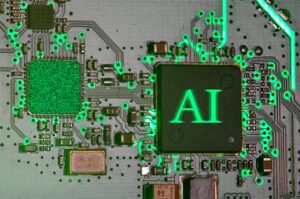How AI Is Making Cybersecurity More Predictive Than Ever

How AI Is Making Cybersecurity More Predictive Than Ever
Historically, cybersecurity has been mostly reactive, meaning that it has only responded to threats after they have already occurred. This strategy is undergoing a fast transformation as a result of the emergence of artificial intelligence. Organizations are able to avoid breaches rather than just reacting to them because to the capabilities of artificial intelligence systems, which monitor trends, identify abnormalities, and predict assaults before they occur. Predictive cybersecurity moves the emphasis away from damage response and toward proactive protection, which in turn reduces risk and minimizes downtime operations.
Finding Out How Artificial Intelligence Analyzes Threat Patterns
Cybersecurity technologies that are driven by artificial intelligence handle enormous volumes of data coming from cloud systems, endpoints, and networks. Algorithms that learn via machine learning are able to discern anomalous behavior, identify deviations from regular activity, and recognize minor indications that may indicate an assault is imminent. Artificial intelligence has the ability to identify threats that conventional rule-based systems would overlook, such as zero-day vulnerabilities and sophisticated phishing efforts. This is because AI is always learning from new content.
Real-time detection and response to potential dangers
Real-time monitoring of network activity is made possible by artificial intelligence, which also provides rapid notifications for questionable conduct. The ability to rapidly execute established reaction procedures, isolate compromised devices, and block malicious traffic are all capabilities that automated systems possess. This speed is essential because cyberattacks can escalate within minutes, and early response may prevent substantial harm from occurring.
Utilizing Behavioral Analysis to Make Predictions Regarding Emerging Threats
Artificial intelligence can not only recognize existing attack patterns, but it may also anticipate new threats by monitoring behavioral trends. Instances such as odd login times, repeated unsuccessful tries, or abnormal file access patterns are all possible indicators of a potential security security breach. Through the recognition of these signals, companies are able to remedy vulnerabilities before they are exploited by attackers, therefore moving the focus of cybersecurity from reactive mitigation to anticipatory defense.
Mitigating the Effects of Cybersecurity Fatigue and Human Error
Individuals working in cybersecurity are subjected to continuous alarms and intricate systems, both of which might result in human mistake or oversight. AI alleviates this load by filtering out signals that are not relevant, ranking hazards in order of importance, and automating operations that are repetitive. As a result, human analysts are able to concentrate on making strategic decisions, while artificial intelligence takes care of monitoring and danger prediction at scale.
Improving Information Security at Endpoints and Networks
Security that is powered by artificial intelligence secures networks, apps, and devices all at the same time. AI finds possible vulnerability points early on by monitoring endpoint behavior, such as software installs or atypical access patterns. This allows AI to identify potential vulnerabilities. Through the use of network analysis, abnormalities in traffic flow or efforts to gain illegal access may be identified, which enables preemptive actions to be taken before significant harm occurs.
Intelligence on potential dangers and computerized learning
Artificial intelligence systems of the modern era continuously update themselves by gaining knowledge from worldwide threat intelligence sources. Because of this, they are able to identify newly discovered malware signatures, phishing campaigns, or attack pathways without the need for human upgrades. Automated learning guarantees that defenses continue to be up-to-date and predictive, allowing them to adjust in next-to-real-time to threats that are always changing.
Protection against Predictive Attacks in Cloud Environments
Monitoring access patterns, configuration changes, and data migration is one of the ways that artificial intelligence (AI) helps enterprises improve their security as they increasingly utilize cloud services. To avoid breaches that might jeopardize sensitive cloud data, predictive algorithms identify probable misconfigurations or suspicious activities and flag them for further investigation. In situations that use several clouds and hybrid configurations, where human control alone may not be adequate, this proactive approach is very necessary.
Methods of Risk Assessment and Preventative Defense Strategies
In artificial intelligence, risk ratings are assigned to people, programs, and devices based on their behavior and possible vulnerabilities. Once this is accomplished, organizations are able to prioritize actions, patch vulnerabilities, and enhance controls in areas where the risk is greatest. The use of this predictive prioritization enables the optimal allocation of resources, hence minimizing the likelihood of assaults occurring before they take place.
Anti-phishing and Fraud Detection Powered by Artificial Intelligence
The potential of artificial intelligence to anticipate fraudulent activity is beneficial to social networks, e-commerce platforms, and financial institutions. Transaction patterns, user behavior, and communication networks are subjects of analysis by machine learning models in order to identify potentially malicious activities. Using artificial intelligence, companies may avert losses and improve trust between themselves and their consumers by anticipating fraudulent efforts in real time.
Getting Organizations Ready for Potential Cyber Threats in the Future
Because of its predictive powers, artificial intelligence is making cybersecurity more robust. By anticipating attack techniques, simulating probable breaches, and developing defensive measures in advance, organizations may take preventative actions. The use of artificial intelligence-driven predictive security allows organizations to stay one step ahead of hackers, therefore protecting their data, reputation, and the continuity of their operations.
Considerations and Obstacles to Overcome
Despite the fact that AI improves predictive security, it also presents a number of issues. In order to prevent biases or false positives, artificial intelligence models need to be based on high-quality data, constantly monitored, and ethical concerns. Additionally, attackers are using artificial intelligence to construct attacks that are adaptable, which is creating a perpetual arms race in the technical realm. Artificial intelligence (AI) insights and human skills are used in successful cybersecurity methods to achieve optimum efficacy.
The Prospects for Artificial Intelligence in the Field of Cybersecurity
Artificial intelligence is anticipated to become completely incorporated into the cybersecurity frameworks of organizations by the year 2030. Self-sufficient network management, instantaneous threat response, and ongoing evolution to handle new attack vectors are all characteristics of predictive artificial intelligence. Within the context of a world that is becoming more digital and linked, this transformation will change cybersecurity from a reactive requirement into a proactive strategy that protects enterprises in real time. This will ensure that organizations are secure.




